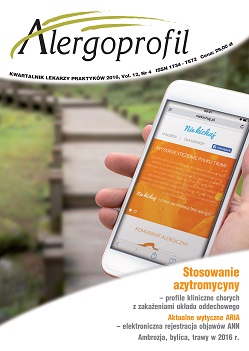Elektroniczne kwestionariusze monitorujące objawy ułatwią diagnostykę i leczenie alergicznego nieżytu nosa
##plugins.themes.bootstrap3.article.main##
Abstrakt
Alergiczny nieżyt nosa (ANN) to najczęstsza choroba w praktyce specjalisty alergologa i jedna z najczęstszych w praktyce lekarza rodzinnego. Schematy leczenia zostały opracowane i wciąż są doskonalone przez inicjatywę ARIA. Mimo to u części chorych nie osiągamy zadowalających efektów. W 2015 r. opublikowano dokument pt.: MACVIA-ARIA Sentinel NetworK for allergic rhinitis (MASK-rhinitis): the new generation guideline implementation. Został on opracowany w celu wykorzystania nowych narzędzi technologicznych i systemu wspomagania decyzji klinicznych w diagnostyce i we wsparciu procesu leczenia ANN. Poprawę skuteczności leczenia ANN może przynieść wykorzystanie aplikacji umożliwiającej śledzenie objawów ANN.
Pobrania
##plugins.themes.bootstrap3.article.details##
Copyright: © Medical Education sp. z o.o. This is an Open Access article distributed under the terms of the Attribution-NonCommercial 4.0 International (CC BY-NC 4.0). License (https://creativecommons.org/licenses/by-nc/4.0/), allowing third parties to copy and redistribute the material in any medium or format and to remix, transform, and build upon the material, provided the original work is properly cited and states its license.
Address reprint requests to: Medical Education, Marcin Kuźma (marcin.kuzma@mededu.pl)
Bibliografia
2. Brozek J.L., Bousquet J., Baena-Cagnani C.E. et al.: Allergic Rhinitis and its Impact on Asthma (ARIA) guidelines: 2010 revision. J. Allergy Clin. Immunol. 2010, 126(3): 466-476.
3. Hellings P.W., Fokkens W.J., Akdis C. et al.: Uncontrolled allergic rhinitis and chronic rhinosinusitis: where do we stand today? Allergy 2013, 68(1): 1-7.
4. Fokkens W.J., Lund V.J., Mullol J. et al.: European Position Paper on Rhinosinusitis and Nasal Polyps 2012. Rhinology 2012, 50(1): 1-12.
5. Rapiejko P., Lipiec A.: Etiologia alergicznego nieżytu nosa. Post. Dermatol. Alergol. 2013, 31(supl. 2): 7-10.
6. Haynes R.B., Ackloo E., Sahota N. et al.: Interventions for enhancing medication adherence. Cochrane Database Syst. Rev. 2008: CD000011.
7. Bousquet J., Schunemann H.J., Fonseca J. et al.: MACVIA-ARIA Sentinel NetworK for allergic rhinitis (MASK-rhinitis): The new generation guideline implementation. Allergy 2015, 70(11): 1372-1392.
8. Caillaud D., Martin S., Segala C. et al.: Effects of airborne birch pollen levels on clinical symptoms of seasonal allergic rhinoconjunctivitis. Int. Arch. Allergy Immunol. 2014, 163(1): 43-50.
9. Caillaud D.M., Martin S., Segala C. et al.: Nonlinear short-term effects of airborne Poaceae levels on hay fever symptoms. J. Allergy Clin. Immunol. 2012, 130(3): 812-814.
10. Frenz D.A.: Interpreting atmospheric pollen counts for use in clinical allergy: spatial variability. Ann. Allergy Asthma Immunol. 2000, 84(5): 481-489.
11. Annesi-Maesano I., Rouve S., Desqueyroux H. et al.: Grass pollen counts, air pollution levels and allergic rhinitis severity. Int. Arch. Allergy Immunol. 2012, 158(4): 397-404.
12. Rapiejko P., Stankiewicz W., Szczygielski K., Jurkiewicz D.: Progowe stężenia pyłku roślin niezbędne do wywołania objawów uczuleniowych. (Threshold pollen count necessary to evoke allergic symptoms). Otolaryngol. Pol. 2007, 61(4): 591-594
13. Wang K., Wang C., Xi L. et al.: A randomized controlled trial to assess adherence to allergic rhinitis treatment following a daily short message service (SMS) via the mobile phone. Int. Arch. Allergy Immunol. 2014, 163(1): 51-58.
14. Gurol-Urganci I., de Jongh T., Vodopivec-Jamsek V. et al.: Mobile phone messaging reminders for attendance at healthcare appointments. Cochrane Database Syst. Rev. 2013, 12: CD007458.

